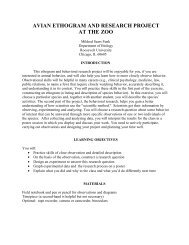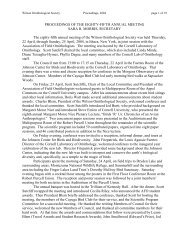Available now - Wilson Ornithological Society
Available now - Wilson Ornithological Society
Available now - Wilson Ornithological Society
You also want an ePaper? Increase the reach of your titles
YUMPU automatically turns print PDFs into web optimized ePapers that Google loves.
WOS 2010 ~ ABSTRACTS p. 12<br />
condition influence a migrating bird’s competency and susceptibility for several zoonotic diseases, including WNV,<br />
eastern equine encephalitis, and avian influenza. Energetic condition is an important factor in a bird’s response to a<br />
viral infection and subsequent antibody response, but not always in the direction predicted and is likely pathogen<br />
specific. Given birds are the likely dispersal agent for a variety of pathogens that infect other animals, both wild and<br />
domestic, and humans, it is essential to understand how fluctuations in their energetic condition, particularly during<br />
migration, affect their competence as a reservoir and their susceptibility to disease.<br />
Symposium 2: The Effects of Energy Development on Birds<br />
S07 Can natural habitats survive the energy revolution Nels Johnson, The Nature Conservancy, Pennsylvania<br />
Chapter, Harrisburg, PA 17110<br />
The Nature Conservancy believes that development of new energy sources in the Northeast has the potential to<br />
cause significant negative environmental impacts—namely habitat fragmentation and reduced water flow and<br />
quality—unless practical planning, siting guidelines and incentives are proactively put in place. The Conservancy,<br />
with technical support from the Pennsylvania Audubon <strong>Society</strong> and Western Pennsylvania Conservancy, is<br />
conducting an intensive 6 month program to analyze how the newest forms of energy development—Marcellus<br />
Shale natural gas, woody biomass, and wind and associated transmission infrastructure—might impact valuable<br />
conservation habitats across the state of Pennsylvania. Existing energy facilities and associated development are<br />
being plotted, the scale and location of future energy development is being projected, and overlaid with data on<br />
sensitive habitat areas and species. Upon completion, the results will be shared with state and federal agencies,<br />
energy developers, conservation groups, and local governments to shape strategies that that can be used to avoid,<br />
minimize, or mitigate energy impacts on high priority conservation areas.<br />
S08 Avian responses to gas well development in West Virginia. Gregory A. George and James Sheehan, WV<br />
Cooperative Fish and Wildlife Research Unit, West Virginia Univ., Morgantown, WV 26506, Petra Bohall Wood,<br />
U.S. Geological Survey, WV Cooperative Fish and Wildlife Research Unit, West Virginia Univ., Morgantown, WV<br />
26506, and Harry Edenborn, National Energy Technology Laboratory, U.S. Dept. Energy, Pittsburgh, PA 15236<br />
Natural gas deposits across the central Appalachians are a valuable commodity due to increased energy demands<br />
and advancements in technology. The forests of the central Appalachians also are key areas for conservation of<br />
avian populations. Drilling activities on our study area occur primarily in stream valleys and on ridges, and result in<br />
heavy equipment disturbance when building well pads, ponds, and access roads within the forest-dominated habitat<br />
matrix. To quantify the effects on breeding birds, we conducted songbird point counts (n = 142) during the 2008-09<br />
breeding seasons on ridges and streams on a study area of ~3,400 hectares in Wetzel County, West Virginia. We<br />
compared avian species abundance and richness between points in undisturbed forest and points in forest impacted<br />
by roads, clearings, and forestry activity. At the current level of habitat disturbance, we identified few negative<br />
effects on forest-interior species and found an increase in species richness and habitat available for earlysuccessional<br />
species. In 2009, we also investigated nest success and territory density of a riparian obligate<br />
bioindicator, the Louisiana Waterthrush. Based on visual assessment and a habitat suitability index, we found that of<br />
40.7 km of stream reaches surveyed across 15 1st and 2nd order streams, 7.5 km (18%) were impacted by drilling<br />
activities. Louisiana Waterthrush used both impacted and unimpacted riparian habitat for territories (n=70) and nest<br />
sites (n = 42). Nesting success was not significantly different in impacted (54.4%) and unimpacted (66.5%) habitat.<br />
Territories that included impacted habitat were significantly longer (550m) than those in unimpacted habitat (406<br />
m). These data provide a valuable baseline for considering long-term avian response within this changing landscape.<br />
S09 Energy Development and Fragmentation Effects. Kim Van Fleet, Important Bird Area Coordinator, Audubon<br />
Pennsylvania<br />
The habitats upon which many birds and other wildlife depend are currently under siege by rapid pace energy<br />
development like industrial scale wind, Marcellus shale gas extraction and associated infrastructures in<br />
Pennsylvania. This “energy sprawl” is occurring with little regard for the direct and more insidious indirect effects<br />
of habitat fragmentation and loss especially along forested ridges and within large tracts of interior forest. In<br />
addition no attention has been directed towards the cumulative impacts of project after project on terrestrial<br />
communities and ecosystems across a wider geographic range. Many interior forest bird species particularly<br />
sensitive to habitat disturbance and edge effect and dependent on contiguous tracts of healthy forest for their<br />
reproductive success will be most likely be the greatest losers. The concerns are multi-fold as the clearing of forests<br />
for industrial scale wind and Marcellus shale continue to increase across the forests of Pennsylvania. There is an<br />
urgent need for more science based research and actions that focus on individual projects and the long term<br />
cumulative impacts on these forest communities.





